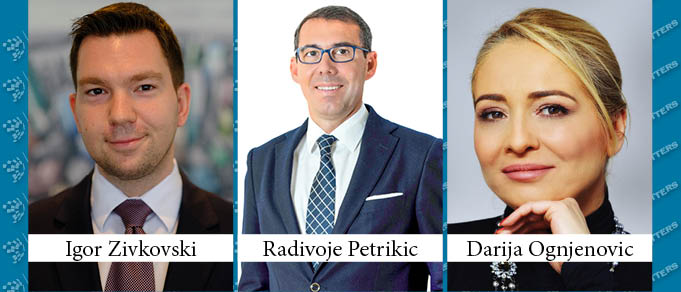Prominent Serbian attorneys provide an overview of the country’s prospects heading out of the recent election cycle and into an uncertain future.
Following a less-then-smooth election cycle, set against a backdrop of public protests amid a global pandemic, the incoming Serbian government – despite holding one of the strongest, most dominant parliamentary majorities in modern Serbian history – will have a lot on its plate to deal with … and soon.
There’s the imminent threat of an economic crisis – as COVID-19 is still very much present – that will force the government to pick and choose carefully how best to keep the country afloat while managing the local effects of a global pandemic. And the incessant issues with an overloaded judiciary, criticized for many years as being slow and subject to inappropriate political influence, leading to a lack of faith in the system and growing calls for reform.
Election Heat
The former Yugoslavian Republics of Croatia, North Macedonia, Montenegro, and Serbia all held parliamentary elections during the summer months of 2020 to elect their leaders for the next cycle.
In both Croatia and North Macedonia, the process went relatively smoothly, with new governments installed in both countries soon after the final votes were tabulated. Even Montenegro, where Milo Djukanovic’s DPS party lost control of the Parliament for the first time in 30 years, saw little disruption.
The fall-out from the Serbian elections, by contrast, was somewhat different.
In February of 2019 Serbia’s leading opposition parties had signed a so-called “Agreement with the People,” promising to boycott the next elections, should it be determined that those elections would be irregular in significant ways. In the lead-up to this summer’s elections most of them promised to follow through on that promise, alleging that the conditions within which the elections were to be held were undemocratic and unfair, and pointing in particular to the heavy support for the current regime in the country’s media.
However, in the weeks before the June 21st elections – which had been postponed from April due to the Covid-19 pandemic – some opposition parties abandoned the block and agreed to participate in the elections after all. This disharmony in the opposition strengthened the position of the ruling Serbian Progressive Party, SPP, led by Serbian President Aleksandar Vucic.
On election day, the coalition around SPP won a supermajority of 60.65% of the vote, translating to 188 seats in the 250-seat parliament. The Socialist Party of Serbia, part of the previous coalition government with SPP and led by Ivica Dacic, won 32 seats, and the new Serbian Patriotic Alliance, led by former water polo player Aleksandar Sapic, won 11 seats. If SPP were to again unite with the Socialists, the coalition would hold 220 seats of the nation’s legislative body with virtually no barriers to the implementation of its agenda.
Protests erupted following the elections, with Serbians taking to Belgrade’s streets and attempting to storm the National Parliament building before being turned away by police. Demonstrations continued for several days, eventually necessitating the use of tear gas and heavy vehicles by the police before eventually dying out.
The most likely cause for the protests, in addition to the wide-spread belief that the elections had not been conducted fairly, was the report that new Covid-19 cases had apparently doubled in the five days following June 21st, with the approximately 90 cases per day reported in the week leading up to the election exploding to between 250-300 just a week later. When President Vucic announced new lockdown measures, protestors accused him and the ruling party of having lied to the country about the extent of the danger in an effort to sway public opinion.
As of writing, the lockdown has not yet been implemented, and the protests have stopped. The new government remains unformed, even though Vucic, on several occasions, claimed that it would be by August 25. The legal limit within which a government must be formed following election day is 90 days – a deadline which is rapidly approaching at the time of writing.
An Economy Open to Investment from All Sides
Overall, Serbia’s economy seems to be doing well. “We’ve been lucky that we’re not too reliant on tourism and those services that the pandemic struck the hardest,” says Radivoje Petrikic, Partner at CMS Belgrade. “With a decent mix of production and services, the economy is not overly dependent on any one sector, which may allow Serbia to bounce back faster than other countries in the region.” He adds that, while the political situation leaves much to be desired, it at least has “some sort of continuity and predictability, which is what investors seek first and foremost – so that’s at least something.”
Igor Zivkovski, Partner at Zivkovic Samardzic, is optimistic that, at least for the rest of 2020, the economy will remain strong. “There are no landmark projects on the horizon right now, but investor interest has been on a good level and I think that Q3 and Q4 will be good.”
In the meantime, Zivkovski notes, the challenge the new government faces maintaining a strong economy in the middle of a public health crisis make big changes especially unlikely. “Keeping the market alive and mitigating the negative fallout in terms of public health will be a tall order,” he says, “which is why I don’t expect any significant changes in terms of the politics of the new government.”
Petrikic agrees. “Generally speaking, I don’t expect there to be any change of course once the new government is appointed.” He feels that the new government will reflect the same mix of “pro-Western and pro-Eastern” interests that the previous government pursued, making it “much like it has been so far.”
Thus, Petrikic says, Serbia will continue to encourage and welcome foreign investment from any and all sources. The country, he notes, is in the “rare position where, in addition to good ties with the West, it also has good infrastructural ties with both Russia and China. Even though that might irk some of the players in the West, this government has been doing a great balancing act so far, and I don’t think that they’ll have any incentive to change.”
Not everyone is so sure, however. Darija Ognjenovic, Partner at Prica & Partners, agrees that “with the election victory freshly won, the SPP has no reason to change their behavior in any way – as far as they’re concerned, they enjoy the trust of the people.” Still, she says, “maybe we’ll see a bit more of a pro-Western turn because the ruling coalition no longer needs to buy social goodwill by praising Russia and China.”
The Covid Context
Serbia experienced its second uptick of Covid-19 cases as the summer started, though by mid-September things had calked down, and the reported numbers of new cases that reached as high as 467 on July 27 had dropped to 36 on September 7. During the first wave of the virus, in March, the Serbian government initiated almost a full two-month lock-down of the country followed by comprehensive economic stimulus packages, but its approach has been more relaxed this time around, with fewer restrictions and less direct help to businesses. Many feel that, although the government’s tackling of the public health aspects deserves praise, its handling of the economy leaves much to be desired.
“We know a lot more about the virus itself now, what it does and how it spreads,” says Petrikic, explaining how the decrease in reported cases was achieved. “The second wave that hit us this summer was controlled much better, sans lockdown, but it remains to be seen what the situation will be come fall and the flu.” Either way, Petrikic has faith that people in Serbia are better prepared than they were in the beginning, and that “each new wave will be more manageable and less hurtful.”
Indeed, Petrikic says, it is of the “utmost importance” to have the people continue moving freely in order to keep the economy moving forward. “Without travel and getting people moving, the economy will grind to a slow halt,” he says.
Perhaps. Ognjenovic, by contrast, thinks that the methods applied by the government to tackle the ongoing effects of the pandemic were less than ideal, at least in the tax world. He contrasts the government’s recent introduction of a voluntary two-month stay on taxes with the three-month stay extended to taxpayers earlier in the year – with the option to pay those tax amounts over 24 months. “This time,” he says, “all they’re doing is postponing when the payments are due for a few months, which means that, come January, there will be a lot more to pay than there usually would.” Ognjenovic believes that this will be burdensome to many taxpayers, meaning that there may not be a “rush to apply for this program.”
Igor Zivkovski says that he hopes that the new government will continue its efforts to stimulate the economy, “especially tourism, transport, and logistics, as these sectors were hit the hardest.” He reports that “the government has issued an additional 60 thousand tourism vouchers to stimulate domestic tourism, on top of the 160 thousand that were issued earlier this year; the National Bank of Serbia has lowered the interest rate to 1.75% to stimulate loans and commercial activity; and an additional RSD 24 billion has been invested in infrastructure projects to stimulate the Serbia 2025 program.”
Reforming Serbia’s Courts
Not all challenges are now, or related to the pandemic. The government must also consider how best to pursue the long-await reform of its judicial system, particularly finding a way to ease the burden on the courts, which are notorious for being overwhelmed and having huge caseloads. Despite the pressing need, howevr, many experts believe that effective reform is unlikely to happen anytime soon.
“Unfortunately, this is an area where things have stalled,” Petrikic says, noting with a sigh that, “while there have been some improvements, it remains a problematic area in Serbia.”
Petrikic insists that the core problem in Serbia’s judicial system is not that there are no qualified judges, but rather that “the judiciary itself is not independent.” According to him, “political interventions are frequent, at least when it comes to non-commercial litigation. Commercial disputes have far fewer of these types of transgressions, but judges can get demotivated there,” he says, referring to low wages. As a result, he says, “there are a huge number of open cases; they take too long to close, and there isnt’t much motivation to do them properly.”
Still, Petrikic says, it’s not all bleak. He notes that access to courts in Serbia is easy and that initiating a legal claim is “inexpensive, compared to other countries,” although he worries that this “only leads to people being more trigger-happy when it comes to deciding to litigate.”
“I do not have a lot of faith in the system, to be honest,” Ognjenovic chimes in. She recognizes that “honorable professionals” exist, but says that they are not a majority. The problem, she notes, is not new. “For the 20-or-so years that I’ve been practicing law, the judicial system has been quite problematic, and I believe it was like that even before.” With obvious frustration, she reports that “the more things change the more they stay the same – every new government promises reforms and improvements, but nothing significant happens.”
Ognjenovic believes that what would help the system most is improving the training provided to judges. “The first thing that ought to be done is to spend more resources and time educating the judges,” she says. “Providing for a specialized, focused education for specific types of cases would present a major move forward.”
Wages, Ognjenovic says, echoing Petrikic, are a major issue as well. “If it’s more lucrative for a legal professional to pursue a career as a lawyer than as a judge – that’s a serious problem that supersedes the issue of not having expert judges.” According to her, “the judges are underpaid and this presents a strong problem. The system should be changed in a way to value the institutions and experts working there more than political parties and strong political personalities.” Until this is done, she says, “we’re going to be running in circles.”
Change, however, may be a tall order. Petrikic says that to efficiently improve the judicial system, a wider political reform must first occur. “The institutions of the country must be independent,” he says. “There must be a political will to create and maintain a system in which the institutions reign supreme – and in which they function properly.” According to him, “if politicians can intervene on every level, we will never have independent institutions.”
“You cannot build this up overnight,” Petrikic continues. “It must be a bottom-up change, people’s faith in the system and institutions must first be won.”
In the meantime, the many and well-known miscarriages of justice over the years in Serbia have led to an absence of faith in the judiciary overall. “It sometimes feels as if there are double standards in play,” Petrikic says. “If you have a situation in which somebody is let off the hook with house arrest following a car accident that resulted in a child’s death, while, on the other hand, folks are being evicted from their apartments for not paying their bills – you’ll never have citizens believing that the system is just and fair.”
Zivkovski agrees, overall, but emphasizes that some improvement has been made, recently – prompted by an unexpected development. “The pandemic forced the courts to be a bit more open-minded to digitalization,” he says. “During the lockdown, there was a lot of pressure to implement certain digital communication solutions to enable the courts to function. This has continued, with certain aspects of enforcement procedures being migrated to an online platform run by the Ministry of Justice.”
At the end of the day, he says, this may help release some of the burden on the country’s commercial courts. And, he says, “with it taking an average of four years to complete a court case in this area, any improvement is a leap forward that is welcomed with open arms.”
Whatever the eventual composition of Serbia’s new government, it will face tough knots to unravel across the board. A drowning judiciary, an unyielding virus, and the potential for an economic crash are sure to keep it busy until the next election cycle. Until then, the country bears watching.
This Article was originally published in Issue 7.9 of the CEE Legal Matters Magazine. If you would like to receive a hard copy of the magazine, you can subscribe here.
















